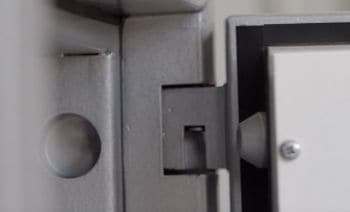A safe is a particular object, a magic object in itself. It is a kind of puzzle for the human mind. It is made with the only purpose not to be opened. That in itself is a feat. But imagine that one person has the ability with the right to do so… So a safe has been designed not to be opened by anyone but the exception of one person with a trick!
It is a puzzle, and many great minds have studied locks for the pleasure of contemplating such a complex mechanism.
How safes are made? Home safes are first and foremost a strongbox made of steel of heavy gauge. Good safes have a double-bodied box with hardened steel. Fireproof safes have fire retardant material in between steel sheet. Then the door of the safe has to be strong with protected hinges and bolts on three to four sides. The lock is either electronic or mechanical and allows the mechanism to be operated by a handle. The door generally has another sheet of hardened steel to protect the lock. Lastly, usually, nylon wires are hidden in the door with the role of blocking the bolts in the case of a drill or a fire.
In many films, safes are a prevalent element of the plot as they hide the most important and precious valuables. They crystallize the desire to hide and the one to show; the will to keep and the impossibility to get. Finding a safe is a game, opening it a puzzle. Let’s see in details how safes are made.
1. Different types of steel, gauges, and welding to make a safe
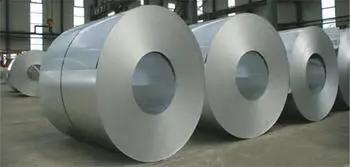
Steel
Steel is already an alloy, made of iron and carbon. The purpose of this addition is to give strength to the metal. Simple safes are usually made of regular steel with no other added element. This basic steel is not even hardened. Such a safe is easy to drill.
Better quality safes can use stainless steel for its better chemical resistance to corrosion and mechanical resistance to drilling and cutting. But stainless steel is harder to work with (stamping and folding) and is more expansive.
Good fireproof safes have an exterior wall made of steel alloy with tungsten. This alloy has a higher melting point and a better overall resistance to heat making a good first barrier before the fire-resistant concrete.
Chromium and nickel steel alloys are used as well by good quality safes for their better resistance and additional hardness.
Lastly, in front of the lock, good safes have an additional layer of manganese steel which is virtually impossible to drill (I couldn’t manage myself…)
Gauge
Gauge sizes are numbers that give the thickness of a piece of sheet metal, with a higher number referring to a thinner sheet. Each gauge size standard differs depending on a given metal because it was developed based on the weight of the sheet.
That is why, for the same gauge, standard steel, galvanized steel or stainless steel have a different thickness.
This is for example a table giving the gauge for stainless steel:
| Gauge | in | mm | lb/ft2 | kg/m2 |
|---|---|---|---|---|
| 13 | 0.0937 | 2.380 | 3.899 | 19.039 |
| 14 | 0.0781 | 1.984 | 3.250 | 15.869 |
| 15 | 0.0703 | 1.786 | 2.926 | 14.284 |
| 16 | 0.0625 | 1.588 | 2.601 | 12.699 |
| 17 | 0.0562 | 1.427 | 2.339 | 11.419 |
| 18 | 0.0500 | 1.270 | 2.081 | 10.159 |
| 19 | 0.0437 | 1.110 | 1.819 | 8.879 |
| 20 | 0.0375 | 0.953 | 1.561 | 7.620 |
The carcass (or box, or body) is made of folded and welded steel sheets. These sheets are of different sizes giving each different resistance, weight, and resistance to the safe.
Of course, entry-level safes use thinner steel sheets, (sometimes even above 20) you could have guessed it. But even if good quality safes are made of thicker gauge steel, a sheet too thick is too difficult to work with (stamp and fold). That is why often two sheets are welded one on the other, especially for the door.
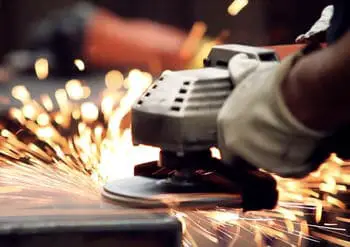
Welding
Among several types of welding, usually, two are most common for safe making.
Shielded Metal Arc Welding (SMAW)
The weld is made by an electric arc between the stick and the metals. The welder uses a manual process of stick welding. This is the most common in the construction of steel structures and industrial fabrication. But this is not the method used for some more complex steel alloys.
Gas Tungsten Arc Gas Welding (GTAW/TIG)
This is also an arc welding process that uses a tungsten electrode to join the metals. With this method, it is possible to weld together thick sections of steel and even stainless steel. It is much more time consuming and difficult to do hence the sticker price of good quality safes.
2. The box or body
Manufacturers start by making the box or carcass.
- Entry level safes.
The box is made of one wall only with medium gauge steel.
In the case of many entry-level safes, the steel is not even hardened. The sheet of steel is cut by a stamp in order to be folded and made into a box. This is really like your kid’s DIY with paper or cardboard. Once the box is made with a special folding machine, edges are welded. The next process is to grind the welds in order to have smooth and clean edges.
You then have a raw box made of steel, with an open side ready to have the door. But this is not the time to install the door just yet.
The box is scoured and receives a special treatment against corrosion before the paint job. The box is painted with a stoved polyester resin powder coating. The last step of the process is an oven in which the paint is dried and hardened. This electrostatic powder coat and baked-on paint give an extremely durable surface.
Then the box waits for its door to be bolted on. - Medium quality safes
For this range of safes, the process is basically the same but there is usually another layer of steel: the body and door are double-walled.
Steel is usually of thicker gauge, and one layer is sometimes hardened. Some safes, for example, one of the German brand Burg-Wachter, are made of stainless steel, harder to cut or drill.
But this is not always the case. Many safes in the $200 to $500 range don’t have hardened steel.
With a double-walled construction, the carcass is stiffer and far more resistant to tearing out of the bolts when anchored to the ground. It is also more resistant to cutting and drilling. - Good quality safes
The body is made of three layers of steel, one of which is hardened. The exterior wall is made of flame cutting protected stainless steel material.Compared to even medium quality safes, these have extreme protection against flame cutting drilling and attack. - Fireproof safes
There are no fireproof safes in the case of entry-level safes. This technology is too expensive for a cheap priced item. But also, the body has to have two walls in order to hold the fire-resistant material inside.
Medium quality safes are used to store documents and thus tested with fire protection: less than 320°F (160°C) inside the safe after 60 minutes at over 1,830°F (1,000 °C). This is far below the ignition temperature of paper so that your papers and documents will be safe in the event of a fire.
Body and door are double-walled. The body itself (the exterior wall) is treated with all-around fire fold that offers additional protection against fire and heat.
All over the body, there is an of sold insulating concrete.
Good quality safes have a three-walled body. The exterior wall is treated with all-around fire fold. The fire insulation contained in the walls of the body or the door is specially designed with fire protection concrete. This material is thicker and in greater quantity than any other safes giving better results against heat. The good quality safes have another advantage: the door gap is extensively sealed with special swelling material that expands under strong heat. The gap is filled preventing hot air to circulate inside the safe and thus keeping as much heat out as possible.
I have researched extensively on fireproof safes and you can read more on that subject in that post.
3. The door
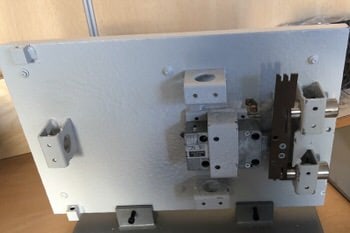
Now that we have seen how the main body is made, it is time to take a closer look at the door.
For many brands, the frame (or box) is made in an automated way. Usually, the grinding of the welds is done by hand. The assembling of the door is also done by hand most of the time.
Remember the puzzle. The perfect safe shouldn’t be opened. The abstract idea of a safe is a closed box with 6 sides welded together with no weak point or gap…
But in practicality, a safe is not perfect and has to be opened. This is the role of the door; in itself, the door is the weakest point of a safe. That is why it is made stronger than the walls of the body.
If the body has a single wall, the door has two layers of steels welded together to give additional protection to the door and the hinges.
In the case of a medium quality safe with a double-walled body, the door is usually made of three layers of steel, one or two of which are hardened.
If the carcass of the safe is full of fire-retardant material, so is the door. There is fire retardant concrete between the first (hardened) sheet of steel and the second. The lock and mechanism are between the second and third sheet. The steel is as well of a thicker gauge.
Bigger safes have doors made of 4 sheets of steel, the first two are hardened and welded together. Between these two and the third is contained the fire retardant material.
In order to protect the lock itself against drills, there is a thick sheet of manganese steel that cannot be drilled.
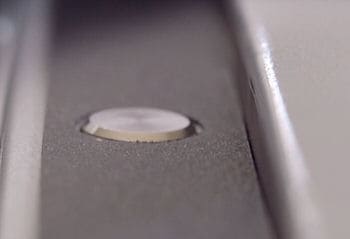
There is an intumescent seal that swells and seals the door in event of a fire. This prevents even more hot air to find a way into the safe and keep the temperature down to a maximum of 320°F (160°C) after 60 minutes at over 1,830°F (1,000 °C).
Once the door is closed, it has to remain closed. The last thing, if we except the lock that we will study further, are the hinges. They can’t just be simple hinges. Because the door opens towards the outside of the safe, the natural places for the hinges to be is outside of the frame. But they just can’t be outside, otherwise, they would be far too vulnerable. This is why safes hinges are difficult to design. They shouldn’t be prominent and are specially conceived with particular protection and a recessed door.
In the inside, the hinges are reinforced by bolts that come into the main frame (either static or mechanically operated).
If a burglar tries to open the safe by cutting the hinges, he won’t succeed in opening the door. They are difficult to get to, difficult to cut; and even if they are broken, the door itself is kept on four sides to the frame.
4. The lock
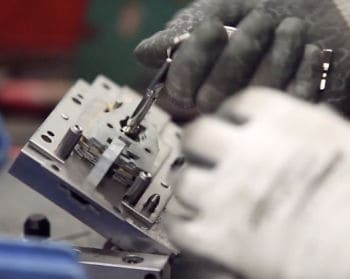
This blog post is about how home safes are made. I have disassembled several safes, both mechanical and electronic, in order to understand how they work and I took many pictures along the way. If you are interested how home safes work, you should definitely read this article.
The 2, 3, or even 4 bolts of the safes are linked together by a mechanism. They slide in and out when operated by the lock. The door has a double role:
- provide authorization (whether mechanical or electronic),
- giving motion to the bolts (whether manual or motorized)
| Type of safe | Authorization | Motion |
|---|---|---|
| Mechanical | key | Turning key |
| Mechanical | Code | Turning knob |
| Electronic | Code | Turning knob |
| Electronic | Code | Motor |
It is interesting to note that electronic safes with a motor are usually cheaper ones. Because a heavy and sturdy mechanism with many bolts are too heavy for a motor and can only be operated by a knob or handle.
- Mechanical lock with a key
This is the simplest construction for a safe. The lock is screwed behind a hardened steel plate with only a hole to get the key in. The key provides authorization and motion to the bolts. - Mechanical lock with a code
It is also called a combination lock or American security safes.
It is strictly mechanical. The lock is itself behind a protecting sheet of steel with a big knob allowing to dial numbers. The step by step process is detailed on the post how safes work and is a must read if you are interested in safes. - Electronic lock with a knob
This is basically made of a keypad, a circuit board, and a screen. If you input the right code, the board acknowledges the code and gives a contact that frees up the lock. But the lock itself remains closed. You hear a small click and you have 3 to 5 seconds to turn the knob. It is your force that you apply to the knob that opens the mechanics that slides the bolt in even though the safe is electronic. It is not automatic nor motorized. - Electronic lock with a motor
For this kind of safes, there is also a keypad, a circuit board, and a screen. The only difference is, when you have just dialed the correct code, a motor will slide the bolts in, and the door will open itself usually with the help of the spring.
The spring has two roles: to help to open the door of the safe, but also, and this shouldn’t be overlooked, the spring forces you to push the door firmly to close it, preventing the bolts to rubbing against the frame and the motor to overheat and fail.
5. Bolts of the lock
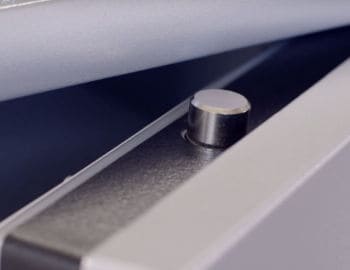
A regular safe has two bolts to hold the door in.
The bolts are made of special material that is almost impossible to cut or saw. But two bolts are not enough and leave the hinges, for instance, too weak.
Better safes have at least three bolts, two to the side and one or more up and/or down to the frame. This gives already far better security compared to two-bolt safes.
Best safes have bolts all-around on four sides of the door. Two bolts on the opposite side of the hinges, one up and one down to the frame, and lastly one or two bolts to the side of the hinges.
These bolts can be “passive” that is to say not operated by the lock itself. They go inside the frame naturally when the door is closed. They have to be of a special shape to work like that. They are good, but not as good as lock-operated bolts that best quality safes provide.
